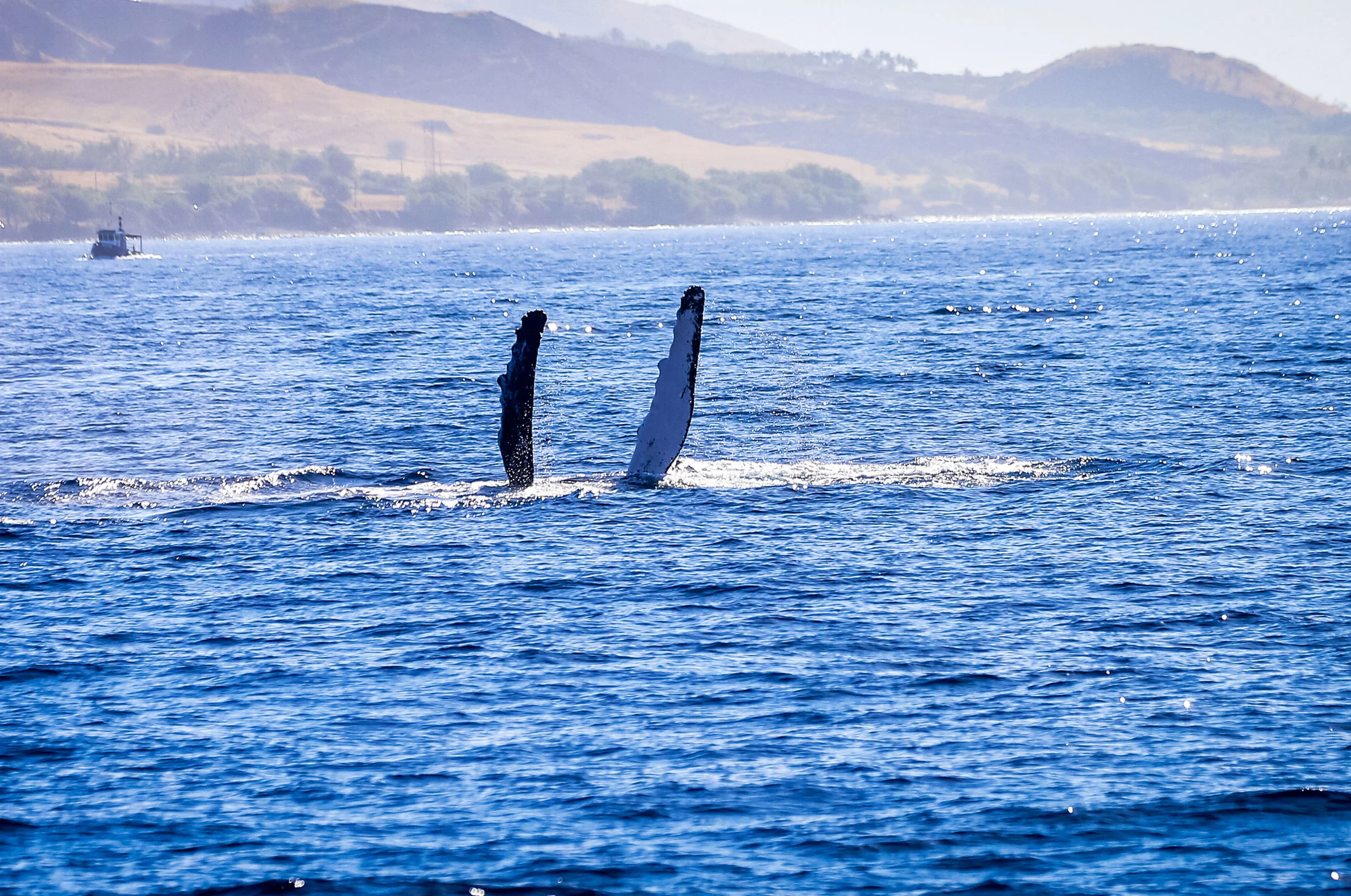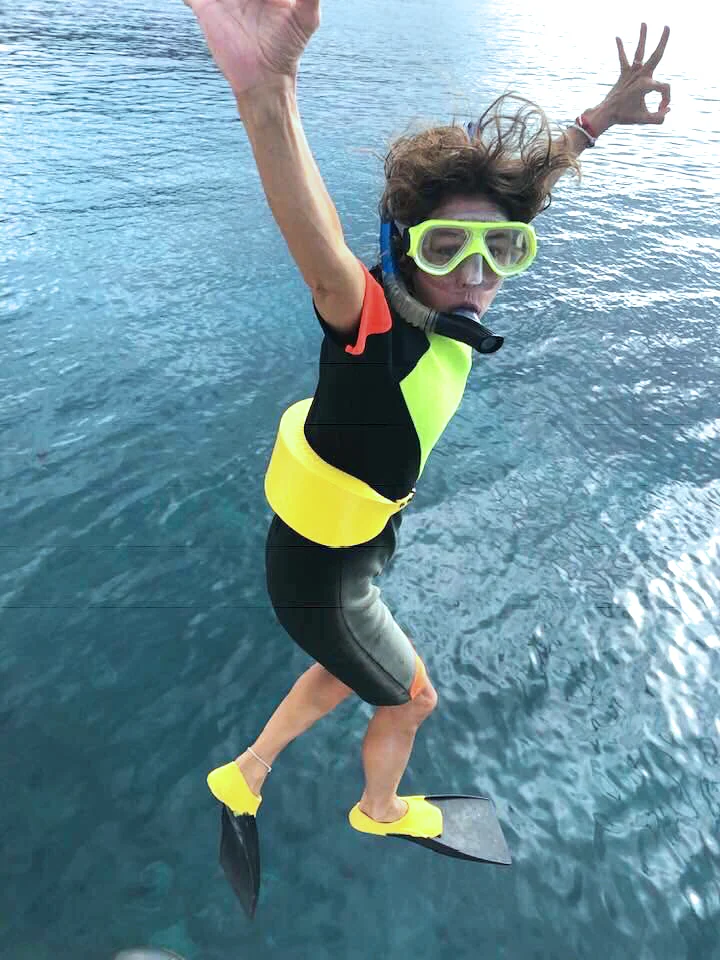Blue'Aina with Malama Kai Foundation and Trilogy Excursions
Here in what is typically a sunny tropical paradise year-round, we’ve actually had a fairly rough weather start to the winter season! Stormy skies, days worth of island-wide rainstorms and even record-breaking snowfall on Haleakala! So needless to say, on the morning of our February 3rd Blue’Aina reef cleanup when our eager volunteers awoke to sunny, clear blue skies, everyone was truly overjoyed! At the usual meeting spot in Lahaina Harbor, we all boarded our gorgeous ride for the day provided by Trilogy Excursions, (who, so it happens, was also our February sponsor!), along with team members from our non-profit recipients, the Malama Kai Foundation, and headed out to Olowalu Reef for a cleanup…
…but not before first taking a liiiittle advantage of peak humpback whale season!
Did you know that the NOAA regulated Humpback whale season in Hawaii is from December 15th through May 15th? While the frequency of whale sightings tends to dissipate mid-April, we were lucky enough to be right at the beginning of peak whale watching time for our favorite gentle giants! The humpbacks put on quite the show for us, complete with pectoral fin slapping, tail slapping, and some close encounters with a small newborn calf. Around 13,000 humpbacks in the North Pacific population make the annual migration between Hawaii’s mating and breeding grounds and the mammals’ feeding grounds in Alaska. That’s close to a 3,000 mile migration each way!
After enjoying the excitement of this unexpected show, our guests settled in as we continued course toward Olowalu. Aboard with us, we had the pleasure of hosting our featured non-profit for the month, the Malama Kai Foundation, who are known locally for helping sustain Hawaii’s coastal and marine resources for both current and future generations. The partnership was a clear winner, as the Foundations’ mission is near and dear to our own Blue’Aina’s cause - “working together with our partners, we seek to enhance marine and coastal protection in Hawaii through education, outreach, and the support of community-based resource management.”
Another fun fact about Malama Kai – they are humbly responsible for the extremely vital day-use mooring program here in Hawaii. Anchor damage is a big threat to the health of coral reefs, one which has been reduced by the installation of hundreds of moorings, funded by Malama Kai. Hawaii’s first day-use moorings were installed on the Kona coast in May of 1990 as an innovative partnership among community members, ocean tourism businesses, non-governmental organizations, and the University of Hawaii Sea Grant Extension Service. State-wide, there are now about 220 day-use moorings in place, spread along the coastlines of our beloved island chain. If you’re interested in more information about day-use moorings, please head over to their website to learn more!
Speaking of which.. as we arrived at our final destination for the day, the Trilogy team used one of these handy mooring spots to anchor down, and we all readied ourselves for some cleaning! As we’ve previously noted, Olowalu reef bears the nickname of Maui’s “mother reef”, being the largest here on island and holding a large diversity of coral species, an abundance of marine life, a green sea turtle cleaning station, and even a black-tip reef shark nursery. Quite the long list of accolades! Some of the coral heads found here date back hundreds of years, and because of that, combined with the particularly high percentage of endemic fish, you are almost always guaranteed to see creatures and sights found nowhere else in the world!
“Endemic – native or restricted to a certain place.”
Looking back toward land, our guests were greeted with the expansive (and jaw-dropping) views of Olowalu Valley, the largest and deepest valley found in West Maui, and home to the island’s ancestral Hawaiian’s for centuries. Long ago, as rain water flowed down the mountains and into Olowalu Stream, fresh, clean water provided these ancient Hawaiians with an abundance of taro, coconut, and breadfruit. And a short walk away along the coast, the protected ocean’s coves generously offered fish, algae, crabs, and sea salt. The final cherry on top? The expansive coral reef that grew here also served as a protective barrier for these humble island dwellers, making the coastline ideal for easily launching fishing & voyaging canoes, alike.
So, what brought our trusty volunteers to Olowalu on this glorious February day? While perfect for providing fresh water to growing plants, the feeding from this mountain stream (combined with residential development in-land) subjects this area to sedimentation and nutrient runoff, which can be harmful for healthy coral reefs. Adding fuel to the fire, this location on Maui is also an extremely popular snorkeling destination, both from the beach and from sea-bound snorkel tours, so it’s no mystery why we tend to find trash settling onto the reefs here. The good news? Luckily on this Blue’Aina underwater reef cleanup we found NO trash – not even one piece! *cheers erupt* A rare occasion, about which we could not have been more pleased. :)
So with happy hearts and full bellies (thanks to Trilogy for providing some yummy noms!), our volunteers sailed back to Lahaina Harbor under the blue skies and sunshine. Success!
Our Blue’Aina reef cleanups are typically held the first Sunday of each month. Head over to our website to sign up for future events. We hope to see you out with us soon!






